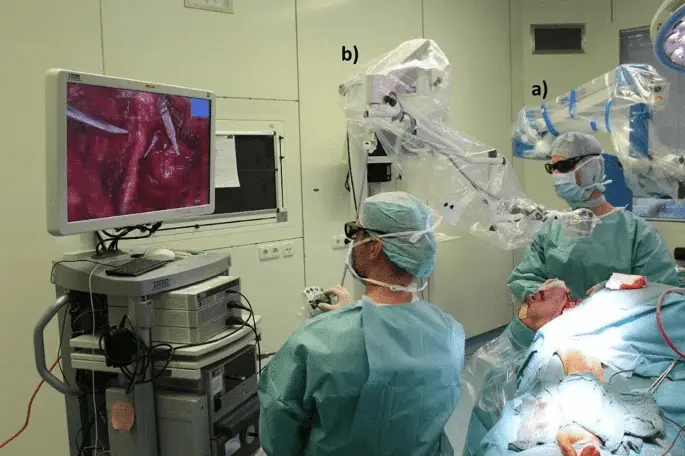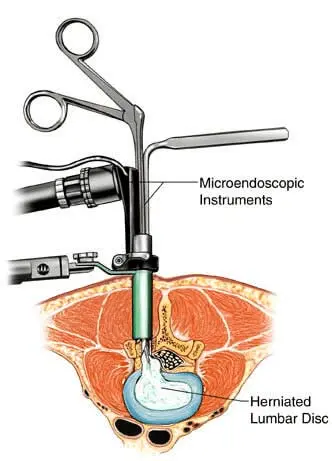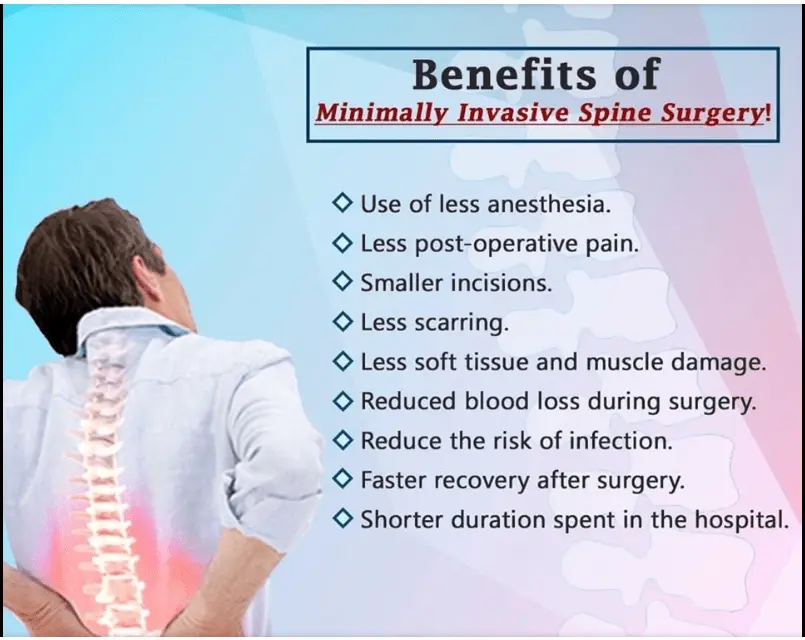Minimally Invasive Spine Surgery
in Mumbai
Whenever Dr. advises surgery the first thing that comes to our mind is about the cost, hospital stay, recovery and scars. Minimally invasive spine surgery in Mumbai, performed by Dr. Uday Pawar, overcomes these issues.

What is minimally invasive spine surgery?
In minimally invasive spine surgery, small incisions are made, which causes less damage to the muscles and tissues.
Minimally invasive spine surgery (MISS) utilizes smaller incisions than traditional open surgery. Through these incisions, surgeons insert a specialized tool called a tubular retractor. This thin, tube-shaped instrument acts like a tunnel, gently pushing aside muscles and soft tissues to reach the targeted spine area.
MISS surgeons rely on advanced technology for precise operations. Small surgical tools are inserted through the retractor to perform the necessary procedures. Additionally, surgeons often use:
High-powered microscopes
These provide magnified views of the surgical area for exceptional precision.
High-resolution cameras
Cameras project magnified images onto a screen, allowing for better visualization throughout the surgery.
Computer-assisted or robotic guidance systems
These advanced systems can improve accuracy and stability during certain procedures.
Real-time X-rays
X-ray imaging provides real-time guidance for surgeons, ensuring they operate on the correct spine area.
This combination of smaller incisions, specialized tools, and advanced technology allows surgeons to perform complex procedures with greater accuracy and minimal disruption to surrounding tissues.
What spine surgeries can be performed using a minimally invasive approach?
Minimally invasive techniques can be used for various types of spine surgeries. As spine specialists, we closely monitor the patient’s condition and decide whether minimally invasive surgery is appropriate.
The following conditions are treated with minimally invasive spine surgery in Mumbai at Dr. Uday’s Spine Hospital.
- degenerative disc disease
- spinal deformities such as scoliosis or sagittal imbalance
- fractures
- bone spurs
- herniated discs
- spinal stenosis
- spinal infections
- spinal instabilities such as spondylolisthesis
Types of Minimally Invasive Spine Surgery (MISS)
Screws and Rods
This MISS uses X-rays to help the surgeon insert screws and rods into your spine. These act like tiny braces to hold your spine in place where it needs support.
Disc Repair
Discs act like cushions between your bones. Sometimes, a disc bulges out (called a herniated disc) and can cause pain. During MISS, a surgeon can remove or fix the problem part of the disc.
More Space for Nerves
When the space in your spine gets too tight, nerves can get pinched and cause pain. MISS surgery can remove some bone or tissue to create more space for your nerves.
Fusing Vertebrae
In some cases, fusing vertebrae (bones in your spine) together can provide more stability. During this MISS surgery, the surgeon places screws removes damaged discs and bone, and adds new bone material to create a stronger section of your spine.
Who is an ideal candidate for minimally invasive spine surgery?
MISS is not suitable for all spine conditions. Factors like patient anatomy and surgical complexity influence candidacy.
People with specific spine problems
MISS is well-suited for conditions like herniated discs, spinal stenosis (narrowing of the spinal canal), and some types of spondylolisthesis (slipped vertebra).
Those who haven't found relief with non-surgical treatments
If physical therapy, medication, and injections haven't helped manage your pain, MISS could be an option.
Individuals with good overall health
Being healthy increases your ability to tolerate surgery and recover well.
Additional factors that might favor MISS
Younger or middle-aged adults
While MISS can be performed on older adults, younger patients generally heal faster and experience fewer post-operative complications.
Those who want a faster recovery
Compared to traditional open surgery, MISS typically leads to a shorter hospital stay and a quicker return to daily activities.
People concerned about scarring
MISS uses smaller incisions, resulting in less noticeable scarring.
Significant obesity
Dr Pawar finds MISS extremely effective in obese patients as it avoids long incisions to access the affected level
However, MISS might not be suitable for everyone. Here's why
Severe spinal conditions
If your condition is very complex or requires extensive reconstruction, traditional open surgery might be necessary.
Patient anatomy
Some patients might have spinal anatomy that makes MISS technically challenging or less effective.
Dr. Uday considers your specific condition, medical history, overall health, and individual needs to determine if MISS is the right approach for you.
How do I prepare for spine surgery?
Here’s a breakdown of what to expect when preparing for spine surgery.
Pre-operative Evaluation
Detailed Medical History
Discuss your overall health, current medications, and any past surgeries with your doctor.
Physical Examination
The doctor will assess your spine, strength, reflexes, and sensation.
Imaging Tests
X-rays, CT scans, or MRIs will be used to visualise the spine and pinpoint the problem area.
Meeting the Anesthesiologist
- You’ll discuss anaesthesia options and the potential risks.
Preparing for Surgery
Adjusting Medications
Certain medications might need to be stopped or adjusted before surgery.
OptOptimisingerall Health
This could involve managing weight, quitting smoking (if applicable) and addressing underlying health conditions.
Arranging Post-Operative Support
Having someone help you at home after surgery can be very beneficial. This could be a family member, friend, or home health aide.
Bloodwork and Lab Tests
Depending on your situation, additional blood tests or lab work might be required.
The Day Before Surgery
Specific Instructions
You'll receive detailed instructions regarding fasting (not eating or drinking) before surgery.
Showering
You might be instructed to shower with a specific soap to reduce the risk of infection.
Packing Essentials
Pack comfortable clothing, toiletries, and any medications you can take after surgery.
What happens during minimally invasive spine surgery?
Minimally invasive spine surgery (MISS) aims to achieve the same surgical goals as traditional open surgery but with smaller incisions and specialised techniques. Here’s a simplified breakdown of what to expect during a MISS procedure:
Anaesthesia
You'll receive medication to put you to sleep (general anaesthesia) or numb only the area being operated on (regional anaesthesia).
Positioning
You'll be positioned on the operating table, typically lying on your stomach or side.
Incision
Depending on the location of the problem, the surgeon will make one or more small incisions in your back or neck.
VisVisualisation Guidance
Surgeons often use high-powered microscopes and high-resolution cameras to magnify the surgical area for better visualization. In addition, X-ray imaging might be used throughout the surgery to ensure precise instrument placement.


Tubular Retractor
A thin, hollow retractor tube is inserted through the incision. This tube gently pushes aside muscles and soft tissues to create a pathway to the targeted area of your spine.
Recovery Room
You'll be monitored in the recovery room for some time before being transferred to your hospital room.
Pain Management
You'll receive medication to manage any post-operative pain.
Physical Therapy
Depending on the surgery, a physical therapist might begin helping you regain strength and mobility.
Hospital Stay
The length of your hospital stay will depend on the complexity of the surgery and your recovery progress.

What are the risks of spine surgery?
Spine surgery, like any surgery, carries some inherent risks. Considering this option, it’s essential to weigh the potential benefits against the risks. Here’s a look at some general risks associated with spine surgery:
Anesthesia Risks
- Reactions to anesthesia medication
- Breathing difficulties during surgery
- Awareness during surgery (extremely rare)
General Surgical Risks
- Bleeding
- Infection
- Blood clots (deep vein thrombosis, pulmonary embolism)
- Damage to nerves or blood vessels near the surgical site
- Leakage of cerebrospinal fluid (CSF) - the fluid that surrounds the brain and spinal cord
Specific Risks of Spine Surgery
- Nerve damage: This can lead to weakness, numbness, or pain in the legs or other areas.
- Spinal instability: If the surgery doesn't achieve proper stabilization, it could lead to pain or further problems in the spine.
- Failure to achieve desired outcome: In some cases, the surgery may not completely alleviate the original pain or symptoms.
- Recurrence of the original condition: There's a possibility that the underlying condition might recur in the future.
Minimally Invasive Spine Surgery (MISS) Risks
While MISS aims to minimize some risks associated with traditional open surgery, there are still some potential drawbacks to consider:
- Limited visualization: Due to smaller incisions, surgeons might have less visibility during MISS than open surgery.
- Technical challenges: MISS procedures can be more technically demanding for surgeons, requiring specialized skills and training.
- Not suitable for all cases: Complex spinal conditions might not be ideal candidates for MISS due to limitations in visualization and instrumentation.
What are the benefits of minimally invasive spine surgery?
Minimally invasive spine surgery (MISS) offers several advantages over traditional open spine surgery. Here’s a breakdown of the key benefits:
Faster Recovery
MISS typically leads to a shorter hospital stay and quicker return to daily activities than open surgery. This is because MISS uses smaller incisions, resulting in less muscle disruption and blood loss.
Reduced Pain
Smaller incisions and minimal muscle disruption also reduce post-operative pain. This can significantly improve your comfort level after surgery.


Improved Cosmesis
MISS procedures use smaller incisions, leading to less noticeable scarring than open surgery.
Reduced Risk of Blood Loss
Smaller incisions generally lead to less blood loss during surgery.
Faster Healing
Less muscle disruption can lead to faster healing of tissues around the surgical site.
Quicker Return to Work and Activities
The faster recovery associated with MISS allows you to return to work, hobbies, and daily activities much sooner than with traditional open surgery.
Lower Risk of Infection
Minimally invasive techniques minimize exposure to the surgical site, potentially reducing the risk of post-operative infections.
Improved Patient Satisfaction
Studies suggest that patients undergoing MISS often report higher satisfaction levels due to faster recovery, reduced pain, and improved cosmetic outcomes.
What should I expect during my recovery from a minimally invasive spine surgery?
Minimally invasive spine surgery (MISS) aims to achieve the same surgical goals as traditional open surgery but with smaller incisions and specialised techniques. Here’s a simplified breakdown of what to expect during a MISS procedure:
Recovery Room
Following surgery, you'll be monitored in the recovery room for some time before being transferred to your hospital room. Nurses will closely monitor your vitals, pain levels, and overall well-being.
Pain Management
You'll receive medication to manage any post-operative pain. This might include pain medication through an IV or oral medication once you can take it by mouth.
Physical Therapy
Depending on the specific surgery, a physical therapist might begin working with you shortly after surgery. They will guide you through gentle exercises to promote healing, improve strength, and restore mobility.
Length of Stay
The duration of your hospital stay will depend on the complexity of the surgery and your recovery progress. MISS procedures typically result in shorter hospital stays compared to traditional open surgery.
Activity Level
Initially, you should get out of bed and take short walks with assistance. Gradually, as you gain strength, you can increase your activity level.
Post-Operative Instructions
Your doctor will provide specific instructions regarding wound care, pain management, medications, dietary restrictions (if any), and activity limitations.
Support System
Having someone to help you at home during the initial recovery period is crucial. This could be a family member, friend, or home health aide.
Physical Therapy
Outpatient physical therapy will likely become a cornerstone of your recovery. The therapist will design a personalized exercise program to strengthen your core muscles, improve flexibility, and restore your normal range of motion.
Pain Management
You might still require pain medication for a while after discharge. Your doctor will gradually taper your medication as your pain improves.
Returning to Work and Activities
The timeframe for returning to work and daily activities varies depending on your job demands and the type of surgery performed. Generally, MISS allows for a faster return to normalcy than traditional surgery.
Gradual Recovery
Healing takes time. Be patient with yourself and focus on following your doctor's instructions and physical therapy plan.
Pain Management
Don't hesitate to communicate any pain concerns to your doctor. They can adjust your pain medication regimen as needed.
Rest and Activity Balance
While rest is important for healing, it's equally crucial to increase your activity level as your physical therapist instructs gradually. This will help prevent stiffness and promote recovery.
Follow-Up Appointments
Regular follow-up appointments with your doctor are essential to monitor your progress and address any concerns.
When To Call the Doctor?
Here’s a list of warning signs to watch for and when to call your doctor after minimally invasive spine surgery (MISS):
Call the doctor right away if you experience any of the following
Severe Pain
While some pain is expected after surgery, if you experience sudden worsening of pain or pain that is not manageable with your prescribed medication, contact your doctor.
Fever
A fever (generally above 100.4°F or 38°C) can indicate an infection.
Redness, Swelling, or Drainage at the Incision Site
These could be signs of infection at the surgical site.
Numbness or Weakness
New or worsening numbness or weakness in the legs or other areas could indicate nerve damage.
Difficulty Breathing or Chest Pain
These could be signs of a blood clot in the lung (pulmonary embolism).
Severe Headache or Confusion
These could be signs of a spinal fluid leak.
Additionally, call your doctor if you experience:
- Difficulty urinating or loss of bladder control
- Increased drainage from the incision site
- Nausea and vomiting that persists
- Inability to tolerate food or drink
- Difficulty sleeping due to pain
What are some of the latest exciting advances in minimally invasive spine surgery?
The field of minimally invasive spine surgery (MISS) is constantly evolving, offering new hope for patients with various spinal conditions. Here are some exciting advancements to be aware of:
Robotic-assisted Surgery
Surgical robots are increasingly used to assist surgeons in MISS procedures. These robots provide enhanced precision and stability during delicate manoeuvres, potentially improving outcomes.
Improved Visualization Techniques
Advancements in high-resolution cameras and 3D imaging technologies allow surgeons a clearer view of the surgical field during MISS. This enhanced visualization can improve accuracy and safety during the procedure.
Emerging Technologies
Technologies like augmented reality (AR) and virtual reality (VR) are being explored for MISS. AR can overlay crucial information onto the surgeon's view, while VR can be used for pre-operative planning and simulating the surgery.
Minimally Invasive Fusion Techniques
New developments in bone graft materials, implants, and surgical techniques are allowing for more minimally invasive approaches to spinal fusion procedures. This can lead to faster recovery times and potentially reduce complications associated with traditional fusion techniques.
Disc Replacement Advances
Artificial disc replacements are becoming a more viable option for some patients with disc degeneration. Disc design and materials improvements lead to better long-term outcomes with these implants.
Focus on Outpatient Procedures
As MISS techniques continue to refine, some procedures that were previously performed in-patient are being transitioned to outpatient settings. This can significantly reduce healthcare costs and improve patient convenience.
If you are looking for an experienced surgeon for spine surgery in Mumbai, Dr. Uday is just a call away.
Frequently Asked Questions
Minimal bed rest is typically recommended after minimally invasive spine surgery. The focus is on early mobilization with physical therapy guidance to promote healing. Dr. Uday Pawar will provide specific instructions based on your procedure.
Return to work after minimally invasive spine surgery is generally faster compared to traditional surgery. Most patients can resume desk jobs within a few weeks, while physically demanding jobs might require longer recovery. Dr. Uday Pawar will advise on a safe return-to-work timeline.
Minimally invasive surgery uses smaller incisions, resulting in minimal scarring compared to traditional open surgery. Scars are usually well-hidden and fade over time.
Travelling after minimally invasive spine surgery is usually possible after a short recovery period. Dr. Uday Pawar will advise on specific guidelines based on your procedure and the travel duration. Long flights might require special precautions.
Patients with certain spinal conditions like herniated discs, spinal stenosis, or fractures might be good candidates for minimally invasive spine surgery. Dr. Uday Pawar will assess your individual case and determine if MISS is the most suitable approach for you.

